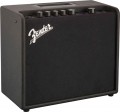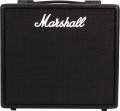Woofer size (LF/MF)
The diameter of the woofer or woofer installed in the combo amplifier. The specific value of this parameter may be different, depending on the number of lanes (see above). In three-way systems we are talking about bass dynamics, in two-way systems — about the dynamics responsible for low and medium frequencies; and if the amplifier does not have band separation, this paragraph indicates the diameter of the main radiator.
In general, the larger the radiator, the louder it can sound and the richer the bass from such a speaker is. At the same time, we note that the speaker diameter is selected by the manufacturer based on the power of the built-in amplifier and the expected sound volume. So the main indicator when choosing is still the rated power, and the size of the speaker is more of a reference value.
Equalizer
Type of equalizer provided in the device design
An equalizer allows you to change the volume of a separate part of the sound range (frequency band), thus changing the color of the entire sound. This is one of the most important functions related to audio settings; therefore, it can be provided directly in the guitar amplifiers themselves. And the type of equalizer is indicated by the number of bands available for adjustment.
The more of these bands, the more accurately you can adjust the sound, but the more complex and expensive the equipment becomes. In light of this, the simplest option involves only
2 bands - low and high frequencies; Often such an equalizer looks like two separate knobs for adjusting the bass and treble levels. At the same time, we note that similar functionality can be found in both budget and high-end guitar amplifiers: in the second case, it is assumed that if finer adjustments are needed, you can use external equipment. However,
three-band solutions (low, mid and high frequencies) are the most popular these days: such an equalizer provides quite extensive possibilities for adjusting the sound and is relatively inexpensive (and if finer adjustments are required, you can use external equipment).
4-band equalizers are noticeably less common, but are also quite popular (including in inexpensive devices); and some models provide
...5 or more (up to 12) adjustment bands.Effects
Built-in effects provided in the combo amplifier. You can also achieve various effects with the help of external “gadgets”, however, such gadgets need to be searched for and connected separately, while built-in effects are available immediately and without unnecessary settings.
—
Overdrive. Distortion in the form of a characteristic electric guitar "buzz" at low frequencies and "howl" at high frequencies, a little softer than distortion. Popular, in particular, in hard rock.
—
Distortion. Sufficiently hard and sharp distortion, similar in sound to overdrive, but more intense and brighter. It is widely used in various styles of metal, and is also found in rock.
—
Reverb. An effect based on simulating multiple decaying echoes from each sound. Depending on the duration and intensity of repetitions, it can give the sound a different colour. Used as an artistic device; among other things, it can create the effect that the guitar sounds in a certain room (concert hall, room with stone walls, an open area in the mountains, etc.). Note that the reverberation can be adjusted both by individual parameters (intensity, echo duration, etc.), and by selecting a preset set of parameters (for example, “sharp sound in the room” or “soft sound in the hall”).
—
Tremolo. Tremolo is basically a trembling effect that res
...ults from small and quick fluctuations in the volume of each note. Sometimes this term means vibrato (see below) — to the point that the manufacturers of guitar amplifiers themselves mean the effect of vibrato by the tremolo effect, and vice versa. So the specifics of this effect in each case should be clarified separately. Anyway, the tremolo can be "fixed" or adjustable in depth (range of volume change) and speed (jitter frequency).
— Vibrato. Another effect of "jerking" sound, which is often confused with tremolo (see above) — to the point that both these terms are used as identical. However, this is not true; the difference lies in the fact that vibrato is carried out due to the rapid fluctuations of the note not in volume, but in frequency. A similar effect can be achieved on the guitar itself by "pulsating" the strings, but using the amplifier's built-in instrument is much more convenient in most cases.
— Chorus. An effect designed to simulate the choral sound of an instrument. To do this, the amplifier copies the sound of the guitar and plays several copies simultaneously with the original signal, slightly shifting them in time (about 20 – 30 ms with a constant change) and frequency. However it is impossible to achieve a full-fledged choral sound in this way, but the effect is quite original in itself.
— Delay. A specific type of reverb (see "Reverb") that has become widespread as a separate effect. Delay simulates a clear single echo from the sound being played; for this, the original signal is copied and reproduced with a certain time delay (at least 50 ms).
In addition to those described above, other effects can be found in modern guitar combo amplifiers, in particular:
— Flanger. The effect is reminiscent of the whistle of a jet engine; it is often compared to a plane taking off. It is created similarly to the Chorus described above, differs from it in a shorter delay time and the presence of feedback.
— echo. Another kind of reverb, similar to delay (see “Delay”). It differs in that in this case the echo is reproduced repeatedly.
— Octaver. An effect in which a copy of it is added to the signal, shifted by an octave or two.
— Wah wah. An effect that produces a characteristic "croak" sound.Built-in compressor
The presence of a built-in compressor in the combo amplifier.
A compressor is a module that "compresses" the dynamic range of an amplifier, in other words, it reduces the difference in volume between the loudest and quietest sound. This provides improved sustain—that is, a note played and not muted sounds longer, at a more even volume, and with a slower decay than without a compressor. On the other hand, the use of this function slightly increases the level of extraneous noise and worsens the dynamics.
Compressors can also be provided in external equipment, but the built-in module is often more convenient: it is available “out of the box” and does not take up extra space.

